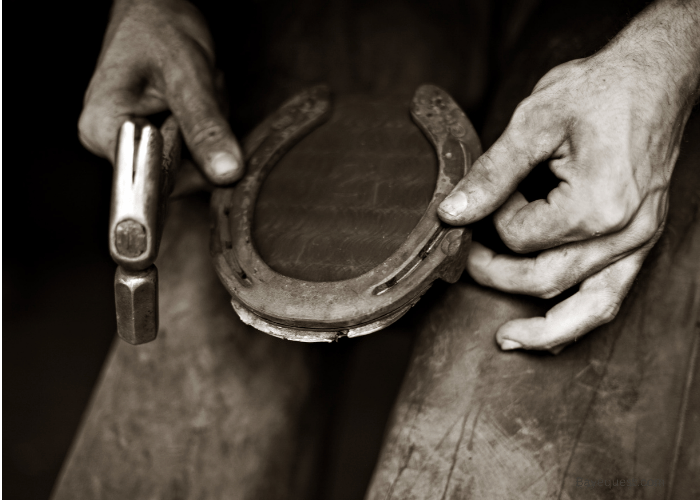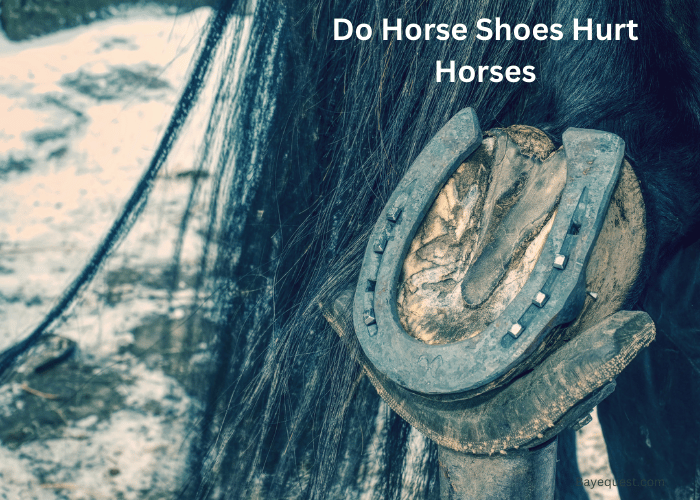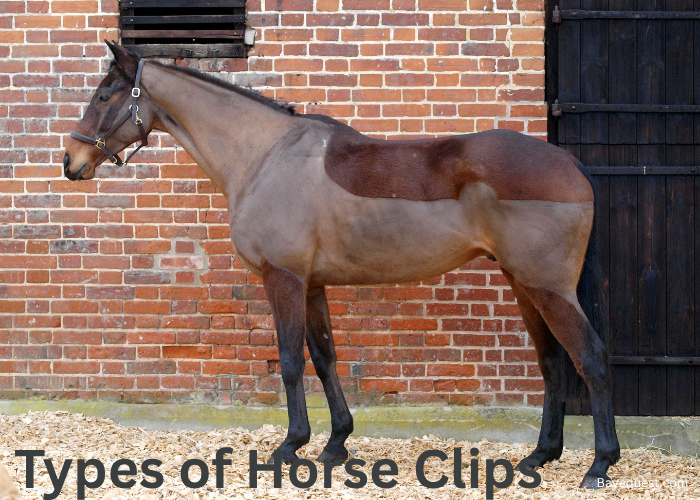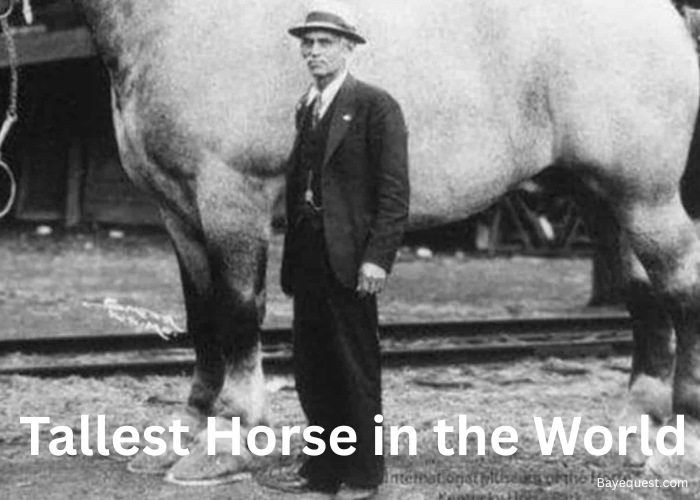Did you know that over 80% of horses wear shoes, raising questions about their comfort? With years of equine care experience, we delve into this crucial welfare topic.
Many horse owners wonder if shoes cause pain. This article explores the balance between protection and comfort.
Join us as we uncover the truth behind the question: Do horse shoes hurt horses?
Do Horseshoes Hurt My Horse? Key Takeaway
Nailing a shoe to a horse’s hoof doesn’t hurt, as hooves lack pain receptors. However, improper shoeing can cause discomfort. An incorrectly fitted horseshoe can irritate the soft tissues of the sole and frog, leading to pain and lameness in horses.
What are Horse Shoes?
Horse shoes, those U-shaped bits of metal, are like the sneakers of the equine world. Those shoes are its protection, its grip on life’s varied paths.
They’re not just about keeping those majestic hooves safe from wear and tear. They’re about ensuring that our four-legged friends can do their job.
Whether it’s pulling a plow, racing towards the finish line, or carrying riders on adventures, these shoes do their job.
Now, let’s take a quick canter back in time. The story of horse shoes starts over a thousand years ago. Back when people realized that just like human feet, horse hooves needed protection, too.
Early versions weren’t the metal plates we know today. Instead, they were leather and plants wrapped around hooves, a sort of ancient hoof boot.
It wasn’t until around the 6th or 7th century that metal shoes nailed to hooves made their debut.
Do Horse Shoes Hurt Horses?
No, horse shoes don’t hurt horses when they’re fitted and applied correctly. Here’s why: think of a horse’s hoof sort of like your fingernail.
The part that gets trimmed and where the shoe attaches doesn’t have nerve endings. So, the horse doesn’t feel that any more than you feel a nail clipper on your nails.
But just like with any part of horse care, it’s all about the skill and knowledge of the person doing the shoeing.
A farrier, which is like a mix between a blacksmith and a specialized vet for horse feet, knows exactly where to place those nails so they go into the insensitive part of the hoof.
They’re kind of like the unsung heroes of the horse world. They ensure each shoe fits just right, not too tight or loose, so it’s comfortable and pain-free.
However, if a shoe is put on improperly, or if a horse has a condition that makes its hooves more sensitive, then yes, there could be discomfort or even pain.
Why Do Horses Need Shoes?
Horses need shoes for several reasons, much like how we wear shoes to protect our feet and help us perform better in various activities. Here’s a simple breakdown:
Protection. Imagine walking barefoot on a gravel road or a rocky path every day. Your feet would be sore and damaged pretty quickly, right? Horse shoes act as a protective barrier between the rough ground and the horse’s hooves, preventing wear, cracks, and other injuries.
Traction. Just like cleats can help a soccer player keep their footing on the field, horse shoes can give horses better grip. This is crucial for activities like jumping, dressage, or simply trekking over slippery or uneven terrain. It helps prevent slips and falls, keeping the horse and rider safe.
Support. Some horses have issues with their hooves or legs that can be corrected or alleviated with the help of specially designed-shoes. It’s similar to how orthotic shoes can provide support and improve comfort for people. These corrective shoes can help distribute weight more evenly or align the hooves properly.
Health. Continuous wear and tear without protection can lead to serious hoof problems. Shoes help maintain the health of the hoof by reducing stress on it and allowing any issues to be managed more effectively. Think of it as preventive care, ensuring the hooves remain in good condition.
Read more: Why do Horses Wear Horseshoes?
Dangers of Shoeing Horses
While shoeing is an essential aspect of horse care for many equines, you need to be aware of the risks involved. Here’s a look at some of the dangers associated with improper shoeing:
1. Lameness and discomfort. Improperly fitted shoes can cause discomfort and lead to lameness.
2. Hoof damage. Incorrect nailing can damage the sensitive structures of the hoof, leading to pain and infection.
3. Changes in hoof dynamics. Shoes can alter the natural expansion and contraction of the hoof upon impact with the ground, which can affect the overall health and strength of the hoof.
4. Development of poor hoof conformation. Continuous use of shoes without adequate breaks can lead to poor hoof conformation. This includes underdeveloped frogs, contracted heels, and thin soles.
5. Risk of slipping. Depending on the environment and the type of shoe used, shod horses may have an increased risk of slipping, especially on hard, slick, or wet surfaces. This can lead to falls and injuries to the horse and the rider.
6. Tendon and ligament strain. The alteration of the horse’s natural gait due to shoeing can put additional strain on tendons and ligaments. Over time, this can increase the risk of strains, sprains, and other soft tissue injuries.
Interesting read: Different Types of Horse Riding Styles.

Are There Different Kinds Of Horseshoes?
Yes, there are different kinds of horse shoes, each designed for specific purposes and hoof conditions. Understanding these variations helps in selecting the right type of shoe for a horse’s particular needs.
Here’s a rundown of some common types:
Regular shoes. These are the most basic type, made of steel or aluminum. They’re used for general purposes to protect the hoof from wear and tear.
Corrective shoes. Designed to address specific hoof or leg issues. They can help correct uneven hoof wear, support limb abnormalities, or alleviate discomfort from conditions like navicular disease or laminitis.
Racing shoes. Made from lightweight materials like aluminium, these shoes are designed for racehorses to enhance performance without adding unnecessary weight.
Therapeutic shoes. Aimed at horses with particular hoof problems, these shoes provide relief and aid in the healing process. For example, a horse recovering from a hoof injury might wear a therapeutic shoe to help distribute weight away from the injured area.
Slip-on shoes. As the name suggests, these are easier to put on than traditional nailed shoes and can be used temporarily or when immediate protection is needed.
Studded or calked shoes. These shoes have added traction devices for horses working or competing on slippery surfaces, such as ice or mud.
Glue-on shoes. An alternative to nailed shoes, these are attached with special adhesives. They’re often used for horses with damaged hooves or those who cannot tolerate nail shoes.
Plastic or rubber shoes. Designed to provide extra cushioning and shock absorption, these shoes are suitable for horses with sensitive hooves or for those that need additional comfort.
Bar shoes. These have a metal bar that connects the two ends of the shoe, offering extra support for the heel or injured parts of the hoof.
Are There Modifications To Horseshoes?
Yes, horse shoes can be modified in various ways to better suit the specific needs of a horse. These modifications are tailored by skilled farriers to enhance comfort, improve performance, or correct medical issues.
Here are some common modifications:
Pads. Pads can be placed between the horse’s hoof and the shoe. They’re used for additional cushioning, to distribute weight more evenly, or to protect the hoof from harsh ground conditions. Pads can be made of various materials, including rubber, plastic, or gel.
Wedges. Wedge-shaped pads or shoes that elevate the heel or toe, adjusting the angle of the hoof. This can help correct conformation issues and alleviate strain on tendons and ligaments.
Clips. Clips are small projections on the shoe that help secure it to the hoof, reducing movement and wear on the nail holes. There are toe clips and side clips, depending on where they’re placed on the shoe.
Drilled and tapped shoes. For horses needing extra traction, such as those competing on grass or in slippery conditions, shoes can be drilled and tapped. This allows for the temporary addition of studs or caulks to the shoe’s bottom.
Roller or rocker shoes. These shoes have a rounded or curved toe, facilitating a smoother movement for the horse. They can assist horses with certain gait abnormalities or help reduce stress on specific parts of the hoof and leg.
Heart bar shoes. A type of bar shoe that includes a metal “heart” over the frog (the V-shaped part of the hoof). These provide extra support for the hoof, particularly beneficial for horses with conditions like laminitis.
Egg bar shoes. Extend beyond the back of the hoof, offering additional support to the heel and leg. Useful for horses with navicular disease or tendon issues.
Glue-on tabs. For shoes that are glued rather than nailed, modifications can include tabs that extend from the shoe and adhere to the hoof wall, providing additional stability.
How Do I Clean A Shoed Horse’s Hoof?
Cleaning a shoed horse’s hoof is an essential part of horse care. Always ensure the hooves remain healthy and free from debris that could cause discomfort or infection.
Here’s a step-by-step guide to cleaning a shoed horse’s hoof, making the process as straightforward as possible:
Step 1: Secure your horse
Make sure your horse is standing on a stable, flat surface.
Secure your horse in a way that’s comfortable and safe for both of you. Some horses are trained to lift their hooves on command, while others may need a gentle cue.
Step 2: Pick the right tools
Have a hoof pick and a stiff brush ready. The hoof pick is used to remove debris, and the brush is for cleaning off any remaining dirt.
Step 3: Pick up the hoof
Approach your horse calmly from the side.
Gently run your hand down the leg that you’re going to start with.
Cue your horse to lift its foot. You might need to squeeze or tap the fetlock or use a verbal command, depending on your horse’s training.
Step 4: Clean the hoof
With the hoof in one hand, use the hoof pick in the other. Start from the heel and move towards the toe, carefully picking out mud, stones, and debris lodged in the hoof and around the shoe.
Be gentle but thorough around the frog (the softer part of the hoof) and the crevices around the shoe to avoid causing discomfort.
Use the brush to sweep away any remaining dirt and debris, paying close attention to the area around the nails and the shoe itself.
Step 5: Inspect the hoof and shoe
Once the hoof is clean, inspect it for any signs of injury, cracks, or thrush (a common hoof infection). Also, check the shoe to ensure it’s securely attached.
Loose nails or a shifting shoe can cause discomfort and may need a farrier’s attention.
Step 6: Place the hoof down gently
Don’t drop the hoof; instead, lower it gently back to the ground, allowing your horse to place its foot down comfortably.
Step 7: Repeat with the remaining hooves
Move around your horse, repeating the process for each hoof.
The Barefoot vs. Shoeing Debate
The debate between keeping horses barefoot vs shoeing them is rooted in differing philosophies.
Advocates for keeping horses barefoot argue that it allows for natural hoof movement and growth. They contend that many horses can perform just as well, if not better, without shoes.
On the flip side, shoeing protects the hoofs against wear and injury, especially in working horses or those on hard, abrasive surfaces. Shoes can also provide necessary traction and support for specific activities.
Critics of barefoot keeping point out increased hoof sensitivity and discomfort in harsh conditions. Shoeing detractors on the other hand raise concerns about the risk of improper.
All in all, the optimal choice depends on individual horse needs, workload, and environmental conditions.
How Do Horseshoes Not Hurt Horses?
Horseshoes do not hurt horses because the outer part of the hoof has no nerve endings. It’s like our fingernails; trimming them doesn’t cause pain.
Skilled farriers nail the shoes into this insensitive area. Proper fitting is crucial. If the shoes are placed correctly, they protect the hoof without causing discomfort.
Regular maintenance ensures the horse remains pain-free.
Related read: When Were Horseshoes Invented?
FAQs
How often do horses need new shoes?
Horses typically need new shoes every 4 to 6 weeks. This timing aligns with the natural growth rate of their hooves. Just as our nails grow and need trimming, a horse’s hooves grow and require reshaping and new shoes to maintain proper foot health and function.
Read also: How often do horses need to be reshoed?
Do barefoot horses still need to be trimmed?
Yes, barefoot horses still need regular hoof trims. Even without shoes, the hooves continue to grow and can become uneven or overly long, potentially leading to discomfort, poor gait, and structural issues. Trimming every 4 to 6 weeks helps maintain the natural shape of the hoof.
Are there alternatives to metal shoes?
Yes. There are alternatives to traditional metal horse shoes. Some of these include:
Composite shoes: Made from synthetic materials, offering a lighter, more flexible option.
Hoof boots. Removable boots that provide protection and support only when needed, ideal for varied terrain or temporary conditions. Read our article to find out the best hoof boots for trail riding.
Glue-on shoes. A nail-free option for horses with sensitive hooves or those prone to hoof wall damage.
How do wild horses survive without horseshoes?
Wild horses manage without horseshoes thanks to natural selection and their environment. Their constant movement across varied terrain naturally trims their hooves and strengthens hoof structures. Additionally, wild horses have the ability to avoid ground that could be overly harsh on their hooves. Their lifestyle ensures only those with the strongest hooves survive and reproduce, perpetuating strong hoof genetics.
Conclusion
And there you have it, a trot through the world of horse hooves. Whether shod or unshod, the path to hoof health is paved with care, knowledge, and a touch of nature’s wisdom.
Remember, every horse is a story, their hooves the pages on which their lives are written. So, consult the sages, your farriers and vets, to choose the best footing for your noble steed.
In the end, whether clad in metal or bare, what matters most is the journey you share. Happy trails.








